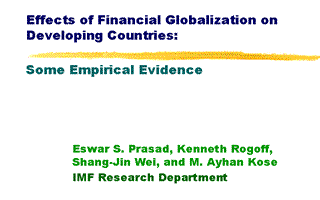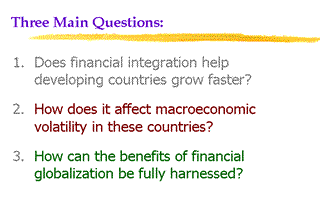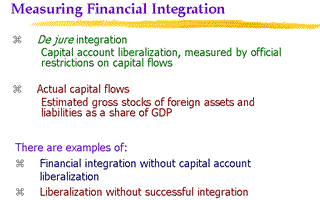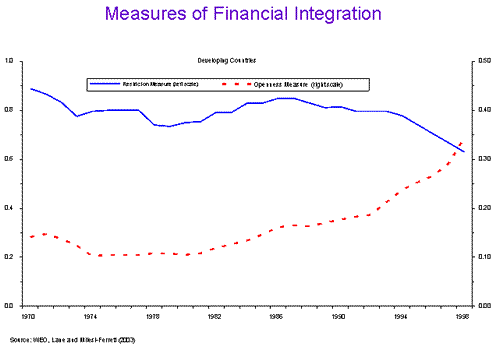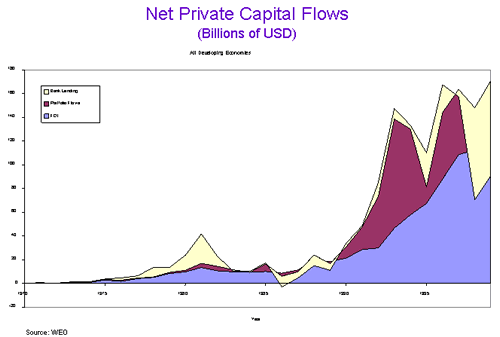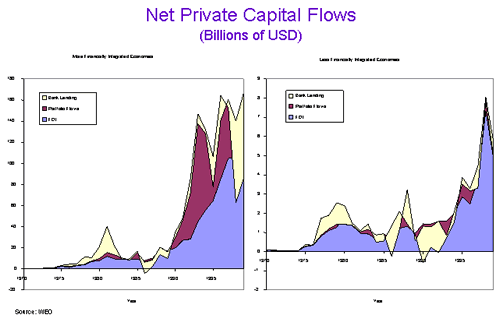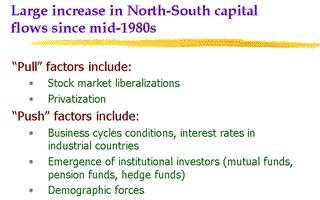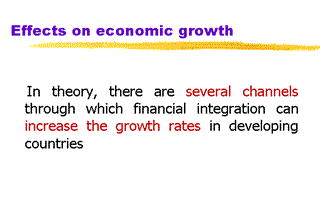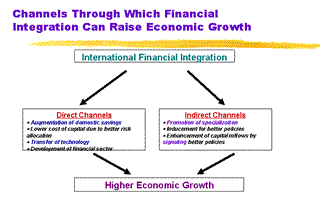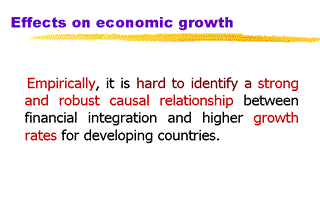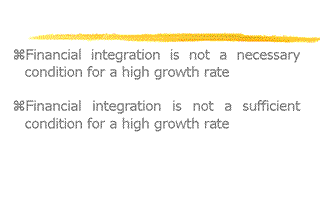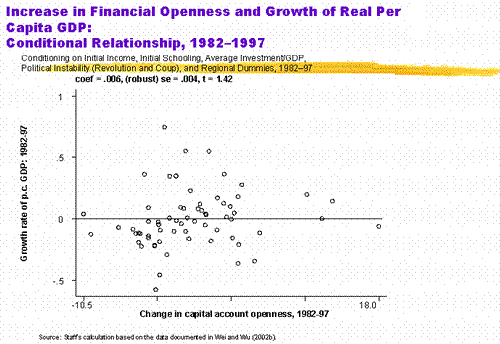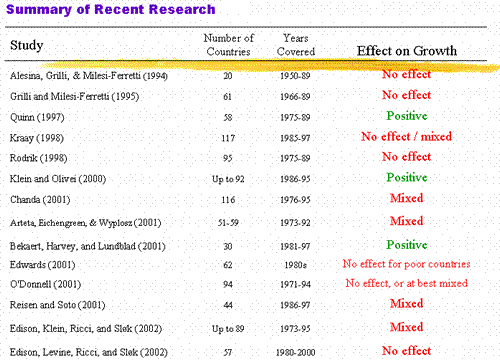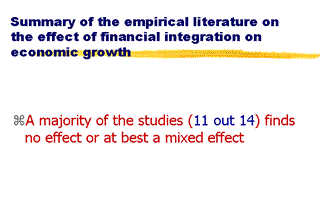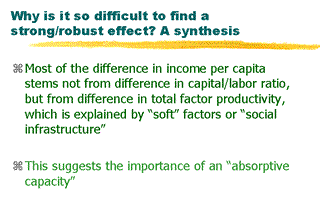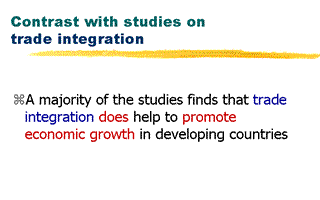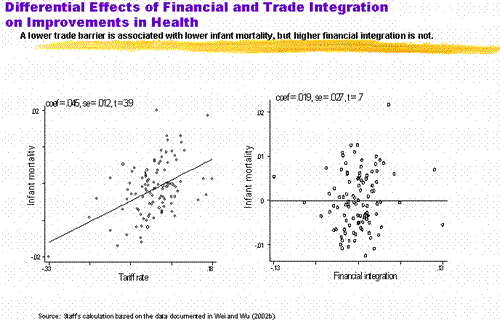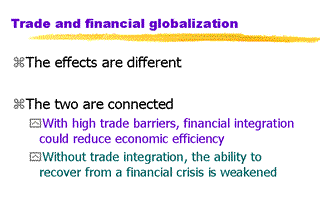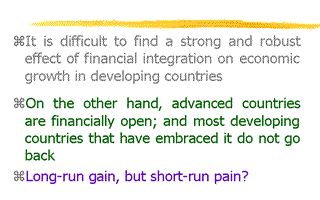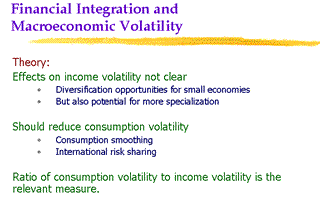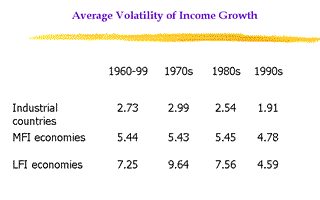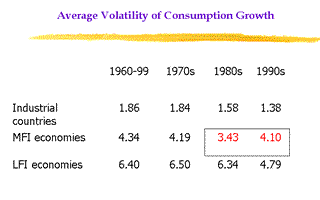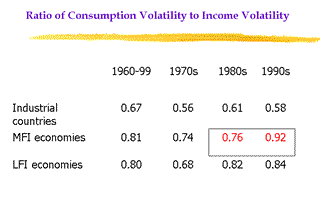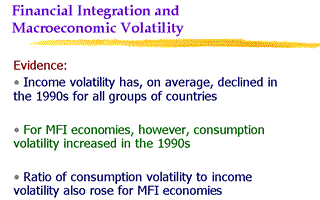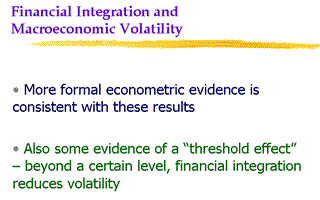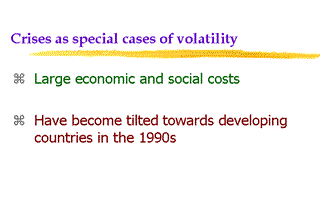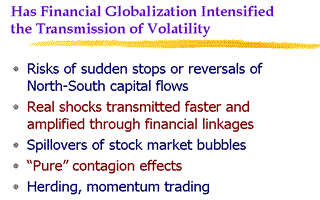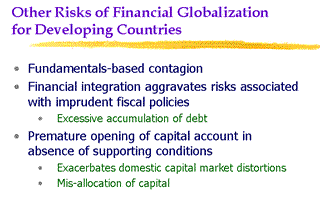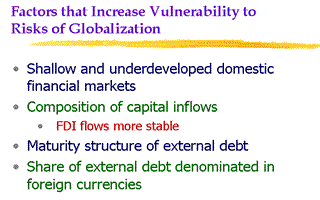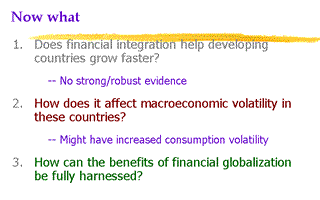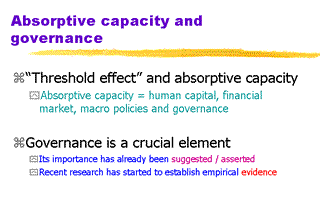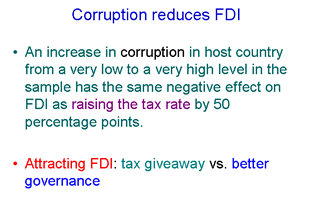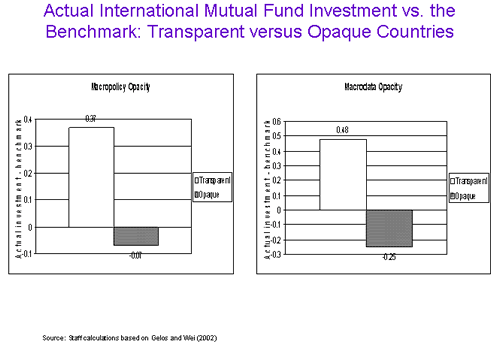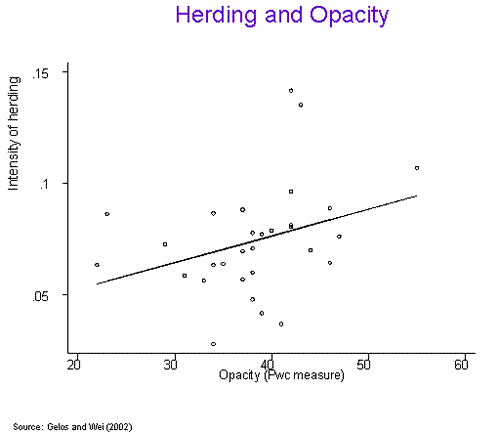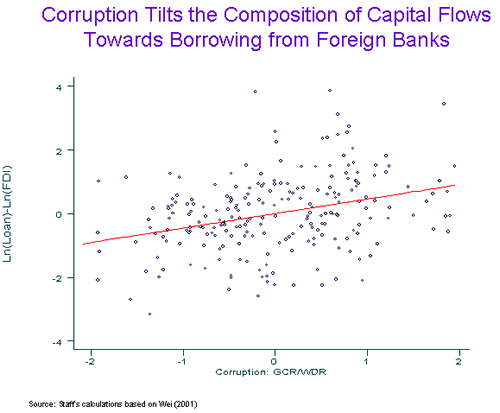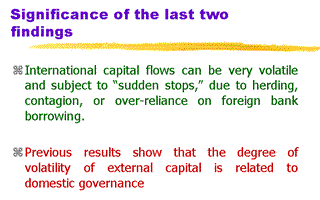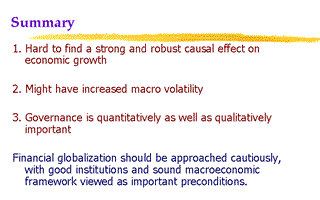Transcript of an IMF Economic Forum: Is Financial Globalization Harmful For Developing Countries?
May 27, 2003
Washington DC, May 27, 2003
(View this Economic Forum using Windows Media Player.)
Participants:
Kenneth Rogoff (Moderator), Economic Counselor and Director of the Research
Department, IMF
Eswar Prasad, Assistant to the Director, Asia and Pacific Department,
IMF
Shang-Jin Wei, Advisor, Research Department, IMF
C. Fred Bergsten, Director, Institute for International Economics
Jeffrey Frankel, Professor of Capital Formation and Growth, Kennedy
School of Government, Harvard University
Daniel Tarullo, Professor of Law, Georgetown University Law Center,
Georgetown University
MR. STARRELS: Welcome to all of you. This is our fourth economic forum in our annual series, and today we will be discussing the subject of financial globalization. The chair of today's session is Mr. Kenneth Rogoff, the Economic Counselor of the Fund, and the Director of the IMF's Research Department. Ken, the floor is yours. MR. ROGOFF: Thank you very much, John, and welcome to all of you who have come this morning, and we're going to talk about financial globalization. Certainly the idea for the Forum was inspired by much interest we've had in the paper that the Research Department at the Fund recently released on the effects of financial globalization on developing countries, some empirical evidence, and I have to my right two of the co-authors of the paper, Shang-Jin Wei and Eswar Prasad, both of the International Monetary Fund, and I myself am actually a co-author as well. We have three very distinguished panelists to share with us their thoughts on the general issue, and they will speak in alphabetical order. The first is Fred Bergsten, who is the Director of the Institute for International Economics, and I think needs no introduction here; and Jeffrey Frankel, who is a Professor of Economics at the Kennedy School at Harvard University and a former member of the Council of Economic Advisers under President Clinton; and, finally, Dan Tarullo, who is a Professor of Law at Georgetown University and a former high-ranking official in the Clinton administration. Before I turn the floor over to Shang-Jin and Eswar, I thought I'd just make a couple of introductory remarks. First, with respect to the IMF paper on the Effects of Financial Globalization on Developing Countries that the Research Department released, it is true that the paper probably emphasizes more than usual that when it comes to financial globalization and developing countries, the glass can be half-empty, as well as half-full. Now, some polemicists have interpreted the paper as a retraction of IMF views on financial globalization, and this is certainly not the case. Indeed, this work builds on work done in the Research Department elsewhere in the Fund, done elsewhere in the profession over the last 20 years, and I think the results flow very naturally from that earlier work. Then, just a couple of specific points about the paper. First of all, the definition of financial globalization here is de facto what actually countries do, not de jure what they say. There's much talk about capital controls, but these are very difficult to measure, enforcement often varies, and there other factors, such as geography, that matter a lot. Capital flows often follow trade flows, which themselves are very closely linked to geographical proximity, and so the paper looks at how much countries are actually financially globalized, and it's not about capital controls per se. Secondly, the paper doesn't raise the issue of exchange regime. That is left for future work, and it isn't discussed in great detail in the paper, but one certainly might argue that some of the problems that we find with financial liberalization might be much less in a world of flexible exchange rates than a world of fixed exchange rates. Certainly, capital account liberalization that might have been premature or too fast was a contributory factor in the Asian crisis. I think everyone agrees on that. On the other hand, had there been flexible exchange rates, as many of us were arguing prior to the Asian crisis, had there been flexible exchange rates in Asia, we might have seen a mini Asian crisis, instead of a maxi Asian crisis. These are issues that still need to be explored. And with that, I'll turn the presentation over to Eswar.
MR. PRASAD: Thanks, Ken, and good morning. So this study, as Ken mentioned, was done by the Research Department. Now, the objective of this paper was essentially to provide some empirical evidence on the effects of financial globalization on the developing countries. Given that financial globalization is a very broad and encompassing topic, we decided to focus our attention on three specific questions: First, what is the effect of financial integration on economic growth in developing countries?
What is its effect on macroeconomic volatility? And, finally, how can the supposed benefits of financial globalization be fully harnessed? Now, it should be noted that financial globalization and financial integration are, in principle, slightly different concepts. Financial globalization refers to the worldwide phenomenon of capital flowing more across national borders, while financial integration, typically refers to an individual country's degree of financial integration with the global economy in terms of capital flows. For the purposes of this presentation, we use the two terms interchangeably.
Now, as Ken mentioned, there are two different ways of looking at financial integration. One is simply based on a measure of capital controls; that is, what the legal restrictions are on capital flowing across national borders. However, this turns out not to be a very good measure because capital markets do tend to be smart about finding their ways around these controls. So, in some sense, actual capital flows constitute a better measure of a country's integration into global financial markets. And, in fact, there are examples of financial integration without capital account liberalization. Some Latin American countries in the '80s, for instance, had large capital outflows, although this was not something they desired, even though they did have capital controls in place. On the other hand, many countries in Africa do have open capital accounts, but they are not able to obtain capital inflows, and therefore by this measure they're not really integrated into the world economy.
Now, for developing countries, it turns out that even though the capital account restrictions measure, which is the blue line, has not changed as much over time, there is a dip in this number in the 1990s, showing the capital controls have declined. The surge in actual capital inflows is really quite large, and by that measure of financial integration, on average, developing countries have participated in the process of financial globalization quite actively starting in about the late 1980s.
Now, net private capital flows, which we focus on in this paper, to developing countries really surged starting in the 1980s, and the blue shaded area, which you see at the bottom, which is FDI flows, have been the most important component, although bank lending and portfolio flows in different periods have had different levels of importance.
But one of the striking facts about these capital flows is that a substantial fraction of them have, in fact, gone to a very small group of developing countries, about 25 of them, which are typically called the emerging markets. We refer to them as the more financially integrated economies. And although the two figures look similar, the scales on the two show that there are enormous differences. About 95 percent of the total capital flows from the industrial to developing countries have, in fact, been accounted for by this relatively small group of more financially integrated economies.
What accounts for this large increase in north-south capital flows since the mid-1980s? On the one hand, there are what are characterized as "pull" factors. These are specific factors endemic to the developing countries themselves, and these include developments in those countries such as stock market liberalizations and privatization. In addition, there were a number of "push" factors, which really are factors that pushed capital from the industrial countries to the developing world. These include business cycle conditions and interest rates in industrial countries, as well as the emergence of institutional investors. In addition, demographic forces are likely to play a fairly important role in the years to come. One possibility about financial globalization, or a concern that has been raised, is that in view of recent financial crises which have meant that the financial flows from industrial to developing countries have slowed down, that there might, in fact, be a complete hiatus in these flows or possibly even a much longer-term stoppage. But there are some demographic forces that are likely to lead to a resumption of capital flows. In one sense, as the aging population continues to expand in the industrial countries, there is going to be a pressure for these savings in order to finance the pensions of these older generations to be put in some place where the return to capital is higher. And given that developing countries are typically poor, these pressures for capital to flow from the industrial countries to the developing countries are likely to intensify in the future years. So developing countries will once again very likely face the balance of risks and benefits associated with financial globalization. MR. WEI: Now we turn to the question on the effects of financial integration on economic growth.
The first thing we want to point out is that in theory there are many, many channels through which financial integration can increase the growth rates in developing countries, and these include direct, as well as indirect, channels. The direct channels encompass augmentation of domestic savings, reduction in cost of capital due to better risk allocation, transfer of technologies, development of financial sectors. The indirect channels encompass promotion of specialization, inducements for better macroeconomic and other policies, enhancement of capital flows by signaling better policies. Those channels potentially could increase the economic rates of growth in developing countries.
However, empirically, or in terms of actual experience of developing countries, it turns out to be hard to identify a strong and robust causal relationship between more financial integration and higher growth rates for these countries. In fact, if you look at the fastest- and slowest-growing economies in the last two decades, you will find that certain economies that have managed to achieve very high growth rates, without having really opened capital accounts in all dimensions. In this sense, financial integration is not a necessary condition for a high growth rate.
If one looks at the country experience, one will also find countries that are relatively financially integrated but still fail to achieve relatively high growth rates. In that sense, financial integration is not a sufficient condition for a high growth rate either.
This graph depicts a lack of clear relationship between growth rates of per capita GDP and changes in capital account openness. In fact, of 14 recent empirical studies that have looked into this question, only 3 find positive connection between these two variables. Eleven of them, or a majority of the studies, in fact, fail to find a positive effect or, at best, find a mixed effect.
So the question is why it is so difficult to find a strong and robust effect? Recent studies have suggested that most of the difference in income per capita across countries tends not to stem from differences in capital labor ratio, but from differences in total factor productivity. Total factor productivity differences are explained by soft factors or "social infrastructure," such as control of corruption, rule of law, quality of financial supervisory and other institutions, and so on. This suggests the importance of absorptive capacities in explaining effect of financial integration.
This contrasts with studies on trade integration. On that subject, a majority of the studies, in fact, find that trade integration does help to promote economic growth rates in developing countries.
This is confirmed from a number of different angles. These two charts on the projector sort of contrast the difference between trade and financial integration. The left chart shows that generally there is association between lower tariff rates, in other words, more trade integration, and lower infant mortalities, in other words, improvement in standard of living in developing countries. Whereas, the right chart essentially shows no significant correlation between more or less financial integration and higher or lower infant mortalities.
So therefore we conclude that trade and financial globalization potentially have differing effects. However, the two are also connected. First, with higher barriers to trade, developing countries may encourage certain inefficient domestic industries. In that context, more financial integration could mean more capital flow into less-efficient industries, hence, exacerbating the misallocation of resources. That is one connection. As another connection, one of the mechanisms through which developing countries may recover from a balance of payment crisis is by expansion of exports and accumulation of foreign exchange earnings. In that context, without proper trade integration, a developing country's ability to recover from a financial crisis through that channel is weakened.
To summarize what I just said, empirically, it is difficult to find a strong and robust effect of financial integration on economic growth rate. On the other hand, we note that advanced countries tend to be financially open, and most developing countries that have chosen to be financially integrated seldom go back. So this suggests the possibility that financial integration may entail long-run gains, but there is a possibility of short-run pains. One of the short-run pains is a potential increase in macro volatility. MR. PRASAD: So this pain, in terms of volatility, is something that is obviously of concern to developing countries.
Now, what does theory say? The implications of theory for the effects of financial integration on income volatility are not entirely clear. On the one hand, financial integration provides diversification opportunities for small economies. On the other hand, it does provide a potential for more specialization which could, in fact, increase income volatility. On the other hand, there is a clear prediction that financial integration should reduce consumption volatility. And at a basic level, consumption is really what people care more about than income. Now, consumption, should be smoothed, better, through international financial markets. Essentially, the idea here is that even if countries have country-specific income risk, they can, in a sense, pool their risks using international financial markets and financial instruments that are part of that process. So the question is whether this prediction of theory is borne out in the data. In principle, it's really not just income volatility, which is what people typically look at, but the ratio of consumption volatility to income volatility that matters. In other words, how smooth consumption is, relative to income,matters in terms of welfare comparisons.
Now, if one looks at some simple averages, in terms of volatility of income growth, it turns out that over the last four decades, as one might expect, industrial countries have typically had lower volatility, as measured by the standard deviation of income growth. More financially integrated economies, which tend to be a little more advanced among the developing country group, have slightly higher volatility, while the LFI economies, the less financially integrated economies, had the highest volatility of them all. Now, the interesting thing is what happens going from the '80s to the '90s. And, again, the '90s one can think of as the period when these developing economies really participated in financial globalization. Across the board for all three groups of countries, you will see that volatility declines. For MFI economies, it declines a little bit. Whereas, for the LFI economies, it declines quite substantially.
On the other hand, when one looks at consumption growth, there is a striking result, which is that consumption volatility has, in fact, declined in the '90s, relative to the '80s, for industrial economies and for the LFI economies.
For the MFI economies, on the other hand, which are precisely the countries that undertook financial integration and should have hoped to get lower consumption volatility, their consumption volatility, in fact, rose. And not only did it rise in an absolute sense, when you look at the ratio of consumption to income volatility, that increased as well for these economies. So, in this particular respect, it looks like the prediction of theory doesn't seem to have been borne out. Why is this so?
To summarize, the evidence suggests that income volatility has declined for all groups of countries, while, for MFI economies alone, consumption volatility has increased both in absolute and relative terms.
So what is going on? It turns out that more formal econometric evidence is consistent with these results, but there is also some evidence of a threshold effect. Only beyond a certain level of financial integration do countries see its benefits in terms of lower consumption volatility. In other words, countries that seem to have attained the level of financial integration that industrial countries have, do seem to have seen the benefits in terms of lower consumption volatility. But it seems like the more financially integrated economies are stuck in the middle, where they are seeing the worst of both possible worlds.
Now, of course, when one thinks about volatility, one typically thinks of crises. In our terminology, volatility is a more general phenomenon, and financial crises, which are typically more severe manifestations of volatility are, in a sense, just a special case. But of course it's an important special case because crises, more than general episodes of volatility, have large economic and social costs. But an interesting thing is that although both industrial and developing economies did face financial crises of various sorts in the '70s and '80s, in the 1990s, it looks like developing countries have, to a greater extent, started exerting a monopoly on these sorts of crises. What can account for this?
One possibility is that financial globalization by itself has intensified the transmission of volatility, and there are various channels through which this can take place. For instance, north-south capital flows can be easily reversed, as we've seen in many cases, and shocks can be transmitted much faster when there are financial linkages, as well as trade linkages to transmit these shocks. In addition, spillovers of stock market bubbles, as well as the contagion effects that we've heard about that are boosted by the sort of seemingly irrational behavior of herding and momentum trading in international financial markets all make developing countries more subject to the spillovers of these shocks. But there are a number of other risks as well.
One is fundamentals-based contagion. When countries do not have the macroeconomic fundamentals in place, it used to be the case that these countries could still plod along for a while. In a more financially integrated world, however, a problem in one developing economy can easily force investors to look more closely at the fundamentals of another economy and thereby breed contagion. So, in other words, if countries are close to the brink, the process of financial globalization can very often push them over the brink. In addition, financial integration aggravates certain kinds of risks. If a country is implementing imprudent fiscal policies, it used to be the case that a country was constrained by how much capital it could raise within the country. Now, of course, with the opening of the international financial markets, there is a possibility that countries can accumulate excessive amounts of debts by borrowing from abroad. And then a phenomenon that we've seen in many countries, premature opening up of the capital account, although it seems to bring benefits in the short run, can have fairly severe consequences in the absence of supporting conditions, which include domestic capital market distortions. So, essentially, if capital flows in and the domestic financial sector is not well-equipped or well-supervised to allocate this capital properly, you can have the problem of misallocation of capital.
Thus, there are a number of factors, including shallow and undeveloped domestic markets that heighten the risks of globalization. The composition of capital inflows, in addition, does seem to matter. FDI flows, in general, are more stable and are not reversed as easily. In addition, the maturity structure of external debt and the share of external debt denominated in foreign currencies all seem to matter in terms of increasing the vulnerability of a developing country to financial crises, but it should be pointed out that many of these factors are, in a sense, under the control of the countries themselves, even though international financial markets do, at some level, dictate the sort of borrowing that a country can do, whether it's FDI or bank borrowing. And even though factors like the maturity structure of external debt are, to some extent, determined by domestic factors, it turns out that developing countries, through the policies that they undertake, can, in fact, play a very important role in how these factors do play out.
MR. WEI: So far we have discussed the fact that empirically there is no strong and robust evidence that the financial integration has raised growth rates and the fact that, if anything, financial integration might have increased consumption volatility. Now, we come to a third and last question: how can the benefits of financial integration be fully harnessed? We, earlier, mentioned the notion of absorptive capacity, which refers to a combination of human capital, financial market adequacy, macroeconomic policies and quality of governance.
Here, we would like to emphasize, in particular, that the quality of domestic institutions and governance is a crucial element of that capacity. This notion has been suggested and asserted in various areas. Recent research has provided empirical evidence on this issue.
For example, one recent study suggests that there is a connection between corruption and inward foreign direct investment. Countries with a higher level of corruption, tend to have less foreign direct investments. An increase in corruption from a relatively low level to a relatively high level has the same negative effect as raising marginal corporate tax rates by 50 percentage points, which is not trivial.
And other research has demonstrated a relatively clear association between a country's level of transparency, in terms of macro policies and in terms of corporate governance, and inward portfolio investment. On average, international mutual funds tend to systematically invest less in more opaque or less-transparent countries.
Finally, investors are said to engage in herding, or the tendency to mimic each other's behavior, a pattern that has been alleged to have contributed to volatility in developing countries. That phenomenon, in recent research, has been shown to be associated with a country's lack of transparency as well. For example, this chart shows a close association between less transparency and more herding.
In addition, recent research also shows that quality of governance may affect the composition of capital inflows, in a way, for example, discouraging FDI and, in relative terms, encouraging borrowing from international banks. Hence, less transparency makes any given amount of capital inflows more subject to sudden stops, sudden reversals, and therefore increases the vulnerability of the developing countries.
Just to recap, it has been said that international capital flows can be very volatile, subject to sudden stops due to herding, contagion, over reliance on foreign banks, but the previous studies show that this degree of volatility of external capital, at least in part, is related to quality of a country's domestic governance.
Overall, this Research Department study finds that it is empirically hard to find a strong and robust causal relationship between more financial integration and higher growth rates. Financial integration might have increased the macro volatilities. Finally, domestic governance is quantitatively, as well as qualitatively important in a developing country's experience with financial globalization. Thanks. MR. ROGOFF: Thank you very much, Eswar and Shang-Jin. Now, we'll turn to our three panelists, and you can either speak from here or the podium, as you choose. First, is Fred Bergsten, Director of the Institute for International Economics. MR. BERGSTEN: Let me start by congratulating the authors for a wealth of material, some fascinating analysis on a very important set of questions on which, as Ken said at the outset, there is still a great deal of active debate. But having said that, I must admit to having found the paper to have been curiously unsatisfying, and the reason was encapsulated by Ken when he started this morning's discussion by saying the result of the paper, the bottom line, is the cup is half full, the cup is half empty; not a very clear outcome on this central question. The main puzzle of the paper, as in fact Shang-Jin reiterated I think three times in his presentation, why is it so difficult to find a strong and robust relationship between what happens in the financial sector on the one hand and in terms of the eventual desired outcome of development and growth on the other? As I puzzled about that myself and tried to ferret out why it might be that it was so hard to find the relationship that most of us would at least hypothesize exists, I concluded that the authors may have misspecified the issue. I would suggest an alternative specification of the financial sector issue in analyzing the impact on growth and development and suggest that it might provide a more fruitful avenue for searching for the relationship. When the authors specified their financial sector variable in the paper, they make a distinction between de jure integration, official capital controls and the like, and actual capital flows, which they label financial globalization. But then they, in fact, throw the two terms together, use them interchangeably anyway and do not make what I would regard as the much more important distinction. I would hypothesize that the key difference that should be struck is, on the one hand, liberalization of financial sectors and, on the other hand, liberalization of the capital account. Now, the paper of course references, at various points, the relationship between those two variables. It talks about the interrelationships between them, and they are indeed closely related, but I would suggest there is, in fact, a clear conceptual and empirical distinction between liberalizing your financial sector and liberalizing your capital account to international movements of money, and it is that distinction which may be more important in discerning the implications, particularly of the former liberalization of the financial sector for growth and development. Now, when I refer to liberalization of the financial sector, what of course I have in mind is the opening up of that sector to competitive forces internally and internationally; opening up the sector to foreign participation, especially banks, but insurance companies, money managers and others, without necessarily opening up the economy to movements of capital flow, including by those same foreign participants in the domestic financial sector liberalization process. An important institutional point is that liberalization of the financial sector, at least to the extent it moves beyond unilateral action by the country in question, is often pursued through international trade negotiations, not financial institutions like the Fund or the normal banking operations. The World Trade Organization, in fact, negotiated a major financial services agreement back in 1997 which bound a lot of the liberalization of financial sectors that had already been undertaken and negotiated at least a modest further expansion of that liberalization. China's entry into the World Trade Organization in the last few years is of course a cardinal example where liberalization of the financial sector was agreed as part of a trade negotiation, while the country in question maintained very extensive controls on international capital movements in and out of the economy. So it is clear, I think, that financial sector liberalization can be done without capital account liberalization. There is, in fact, a rich literature on that. We published a major study on it by Wendy Dobson and Pierre Jacquet at our institute a couple of years ago, and I think that is the distinction that I would focus on in future efforts in this area. I would hypothesize, as I say, that financial sector liberalization is much more important than capital account liberalization in pursuing growth and development. It is the chief method for activating several of the direct channels for moving from the financial sector to growth that the authors in fact laid out very nicely. The most important, of course, the development of the financial sector itself, by definition, takes place when you open up that sector per se. That is the way to increase competition in your financial sector, bringing in foreign actors, open it up to the domestic range of actors, as is pointed out in the paper, but you can also achieve some of this through other channels: technology transfer, pressures to improve the regulatory and supervisory framework, a lower cost of capital due to better asset allocation, participation in better corporate governance as the banks improve their ability to evaluate corporate performance in the economy. All this, again, to underline the point ad nauseam, can be done without liberalizing the capital account, and it would seem much more important. Therefore, I would focus on financial sector liberalization, rather than capital flows, as pointed out in the charts here, in looking to establish a clearer linkage between what happens on the financial side and the bottom lines of growth and economic development. There are, of course, a number of policy implications, if that hypothesis is right. The obvious ones of sequencing that we talk about frequently that financial sector liberalization should, at a minimum, precede liberalization of the capital account, but maybe countries should confine themselves to liberalizing the financial sector for quite some time before moving on to opening up the capital account. That, again, is what China seems to be doing now, with some good results, certainly at this point in time. I cannot resist, in closing off this point, in noting that the United States Government, and particularly the Treasury, has badly confused, and I think badly muddied, the issue in recent months and years. There have been recent Free Trade Agreements negotiated between the United States on the one hand, Chile and Singapore on the other hand, where the U.S. Government insisted not only on opening up the financial sector, which I think is quite proper substantively and quite appropriate for a trade agreement, but also insisting that Chile and Singapore liberalize their capital accounts, which I regarded as extraneous to the trade deal, and, in fact, on the argument I'm making now, not necessarily of benefit to the countries involved. And in intellectual terms, the point is simply that that further, I think, muddied the waters between the two concepts, which seem to me to be desirable to distinguish in our thinking about policy and our future analysis in this area. So I would suggest to the Research Department, when it next tackles this issue, to take a hard look at whether it could, in fact, distinguish clearly between these two aspects of financial globalization or financial liberalization and focus on the financial sector, rather than the capital account. My second main point, which I'll make much more briefly because Ken actually made it in his opening remarks when he referred to the much wider proclivity of countries now to use floating exchange rates to offset crisis problems that emerge. The paper correctly points to the increased risk of crisis that results from—and here I deliberately use the term—capital account liberalization, the opening to international capital flows. That's a clear result from the paper. We've seen it, of course, in practice in many countries in the last decade. It should be noted, however, and Ken was saying that, that there are very significant compensatory changes that a number of countries have instituted in their economic policies that would help them avoid or respond more effectively to crises of the 1990s variety, therefore making it more justifiable for them to open up and take the risks caused by increased reliance on international capital flows. The most important of those compensatory changes, the one that Ken mentioned, is of course greater flexibility of exchange rates, where there has been a dramatic shift, over the last decade or so, in the direction of countries relying on fixed, but adjustable, pegs over to managed, but floating, rates that give them much greater defense against crises emanating from this element. In addition, I would note the very large increase in holdings of foreign exchange reserves not only by Asian countries, but by many other emerging market economies. If you look at the change in reserve holdings by the big emerging markets from the pre-crisis period, say, 1994/'5, up until today, you will find that most of them have increased their reserves by factors of two to four, giving them much greater amounts of ammunition to respond to crises that may emerge from the teeter-totter, the see-saw, the reverse flow of capital flows that we see all too frequently. A combination of more flexible rates, much bigger reserves does, I think, provide most emerging markets with stronger defenses against '90s-type crises driven by reversals of capital flows. That obviously does not obviate the risk, it doesn't obviate the cost thereof. It does give them better defenses against those problems, and therefore has to be entered into any calculus of the cost-benefit effect of exposing a country to more crisis risk from increased exposure to international capital flows, particularly through capital account liberalization. My final point will simply be a speculation, a "what if" question that asks what might we be looking at in this area if we were meeting here 10 years from today instead of today? Today, we are concerned with capital flows to emerging market economies. We're asking whether those flows are large enough, what motivates them, what they do for growth, whether they are stable, what's the composition, et cetera. My speculative question is whether, when we meet here in 10 or 20 years from today, we might be asking about capital flows from emerging markets to rich industrial countries on the grounds that, as the demographic and aging transition takes place so profoundly in the industrial world, leading to bigger budget deficits, perhaps external deficits, that the rich countries, as a group, may become increasingly dependent on imports of capital from the rest of the world, particularly, at that time, the still rapidly growing, high-population, relatively young, high-saving countries that we now think of as the emerging markets. The United States, for its own reasons, is already heavily dependent on those capital inflows, to the tune of half-a-trillion dollars or so a year, and many of those have come from emerging markets, the flip side of the capital build-up I just referred to. But as the rest of the industrial world moves in the direction I mentioned, toward twin deficits, if you will, a very possible outcome of the demographics and the aging profile of Japan and Western Europe, it may be that the next research project that the Fund will have to undertake in that period will be capital flows from emerging markets to industrial nations and what effect those have on our growth in the developed world. Thank you. MR. ROGOFF: [Off microphone.] Jeffrey Frankel. MR. FRANKEL: Very good. Thank you. Well, Ken mentioned that the Research Department study on financial globalization has been received, in some quarters, as a sort of revolutionary recantation; that the IMF, the bastion of financial globalization, has now decided that maybe it's not so great after all. And he also mentioned that it's, in fact, a little less of a revolutionary shift than it seems. The Research Department, and others at the IMF, in the past have not had as doctrinaire a view on the subject as one might think. In that respect, it's similar to many of the great icons of globalization that people associate with free trade and that benefits of open capital markets, in fact, have much more nuanced views. A few examples: Bob Rubin is on record saying financial markets often do crazy things. George Soros, it's famous that he's sometimes held up as the icon of speculation, but in his writings he says that financial markets operate like wrecking balls knocking over national economies. You can come up with quotes from Larry Summers, and Jagdish Baghwati, and Jeff Sachs, all of those people on free trade. I think that just means there's a temptation to oversimplify the views of pro-globalizers. Having said that, this study is a bit of a shift. I mean, the IMF has been pretty strong on the benefits of financial integration, and I think the study, as understated and qualified as it is when you read the language, does represent a shift. Of course, there is a clear distinction which needs to be made between the benefits of free trade and goods and services, which most of us continue to believe are clearly there, both in theory and in practice, versus the situation for financial markets, which really is a more complicated issue. Perhaps an even greater historic shift was, and maybe this is a recantation, was The Economist magazine earlier in May had a special section, "A Cruel Sea of Capital." So that, for them, is quite a shift. Maybe May 2003 will go down in history as the time when views had really shifted away from the benefits of free financial markets. Then, there is a temptation to think, well, maybe the apotheosis of financial globalization is a straw man. Maybe nobody really believes, is so naive as to believe that all of these great benefits that we read about in our textbooks are really there, but that's not quite right. It's not quite a straw man. I mean, the models that we academics use, most of them, still have built in these advantages of being able to finance investment more cheaply by borrowing abroad than if you had to do it out of domestic savings, and smoothing shocks, diversifying and smoothing fluctuations and all of the rest of it. As Fred Bergsten mentioned, the U.S. Treasury still, in a sense, bases its policy on this view in insisting that Singapore and Chile or at least it's sharply limiting their ability to have controls on capital inflows as part of these FTA agreements. So it's not completely a straw man. Let me recap, once again, the two big findings that make us worry that financial markets, in practice, don't have all of the benefits that they do in the textbooks. The first one has to do with variability. In theory, capital flows are supposed to be countercyclical. A lot of the point is that if you have a temporary downturn in your economy, you're supposed to be able to borrow from abroad to smooth things over. But, in fact, capital flows are procyclical. They tend to come into a country that's booming, and they tend to go out to a country that is in recession. That much is true even of industrial— [Tape change: Side A to Side B.] MR. FRANKEL: —growing rapidly. That's when our trade deficit gets worse, and we borrow from abroad and when we go into recession, trade deficit falls, and that's true of most industrialized countries. But this study properly focuses on the variability not of the whole economy of output, GDP, but rather on the variability of consumption because that is what the theory most specifically says capital flows are supposed to be able to stabilize, so you don't have to have consumption falling in proportion to the economy in a downturn. And the key finding is that, for developing countries, in particular, those that have liberalized the most with respect to financial markets, have not experienced a reduction in that variability of consumption. To the contrary, they've experienced an increase in the variability of consumption, and that's pretty worrisome. I don't find that surprising if you just look at the record of the crises in emerging markets that we've seen over the last 10 years, going back to Mexico, in December '94, and all of the ones in East Asia and the rest of the world since then. Those were sharp recessions in each case, and it's not surprising that it shows up as a high variability of consumption. What I find most disturbing in this study, in this survey of the state of the art, which is what it is, is the second question, whether countries that are financially open tend to grow more rapidly, on average. That one I really would have liked to see, that, sure, you have these setbacks from time-to-time, and sure it's painful, but that's part of the growing-up process, and that on average, if you financially liberalize, you will, in the long run, grow more rapidly. After all, the United States, in the 19th century, when we industrialized and had our most rapid growth rate, we had recession crashes that were sharper than the ones we have today, but then we pretty quickly picked ourselves up and moved beyond them, and so one would hope that the same would be true of industrialized countries or there is an analogy, I mean, there's lots of analogies in this business, but my favorite—you can pick your cars or planes or trains or favorite mode of transportation, but I actually like the car one because it can be used to make so many different points. So the highway analogy is that financial markets are like superhighways, that they get you where you want to go more rapidly and, yes, you have accidents, and maybe because cars go faster these days, the accidents, when they occur, are bigger than they used to be. But still, on net, we come out ahead. But do we come out ahead? If the variability is no lower, and the growth rate is no more rapid, that is really quite disturbing. What are the implications for the bottom line of policy? Well, I mean, given such a strong conclusion, you'd think there would be very strong implications. They're not quite as strong as you would think. A lot of the things that you would need to do, even if financial markets worked well, like macroeconomic discipline and structural reforms, a lot of them you still need to do. But I have a list of four categories of, well, answers to the question, given that some degree of financial globalization is inevitable, how can we try to make it work as well as possible, to minimize the frequency and severity of crises or these sudden stops? The first is that we should be open to some tinkering on the margins; so, for example, Chile-style controls on capital. It's very important to note that this is different. There is a tendency, both for the proponents and the opponents of capital controls, to lump them all together. There's the Chile-style controls on inflows, and the Malaysia controls on outflows, and the Tobin Tax, and you just throw it all in together. Well, no, they are quite different, in terms of whether we're talking about inflows or outflows, short term/long term, is it a tax penalty or is it quantitative, and it makes a real difference. To my mind, the Chile-style controls on inflows do have a possible role to play during a particular phase in the cycle, when capital is coming in very, very rapidly, and you want to penalize short-term capital. And high reserve requirements on banks' foreign dollar liabilities would be another example of tinkering. The second category of implications is I agree with what Fred said, that it's an important distinction between liberalizing the financial sector, in other words, letting in foreign banks and other financial institutions to offer some competition in your domestic financial system versus liberalizing the flow of capital, and you can do one without the other, and I think that's completely right. One has to ask why does the U.S. Treasury always seem to take this position of trying to get Chile to, for example, to agree not to put on controls. I think there a little bit of political economy is relevant. I actually, on this, do agree with the critics that the Treasury is, to some extent, responding to pressure from Wall Street and from banks who want to be able to play in these markets and want to be able to bring capital in and out freely, and I think the right answer is to give them the first because it is beneficial and not necessarily give them the second in all circumstances. The third implication for how can we make financial markets work to minimize the frequency and severity of crises is to pay attention to the composition of capital flows. And this was actually apparent even before the East Asia Crisis; that for a given current account deficit, given capital inflow, it makes a lot of difference what form it takes. If it's short term, if it's intermediated through banks, if it's denominated in foreign currencies, you're much more likely to get into trouble than to have a crisis. If it's long term, if it's in domestic currency or if it's equity or, best of all, if it's FDI, direct investment, then that reduces the chance of crisis, and the Research Department study talks about that at some length and documents it. Fourth, and finally, is what you're doing with the rest of your economy, particularly institutions, which we now pay more attention to, and we don't just worry about macroeconomic policies, including even here at the IMF, there has been a lot of work on governance, both corporate governance and government governance transparency, low corruption. These things turn out to be quite important—supervision of banks in the financial systems. Actually, one that I put pretty high on the list is countercyclical fiscal policy. Many developing countries actually have procyclical fiscal policy, particularly in Latin America. In a boom, they spend a lot of money, and then in a recession they have no choice but to cut back sharply, and that really makes things worse. In industrialized countries, well, I think in the U.S., we're moving back into a procyclical fiscal policy for the coming decade probably, but usually it's not that, most industrialized countries it's not that procyclical, and at least we got it right in the 1990s, and this I think actually requires institutions because the temptation in a country in Latin America, at the stage when the money is flowing in, there is just very strong political temptation to spend the money rather than running a surplus. To conclude, the paper has—the Research Department study concludes that maybe there's a threshold effect; that at low stages of development, financial liberalization may actually be bad, and then you have to get over a particular threshold, and then maybe it turns out to be good. And this is reminiscent of many findings in development of U-shaped relationships. There's a Kuznet's curve with respect to income and equality, and there's a version of that for the environment, and in many respects there are some things that seem to get worse at first and then eventually get better. Perhaps, the best interpretation of that, and I think the major hypothesis that is now on the table and needs to be explored, is that a prerequisite to making capital controls work well is to have the good institutions, and the rule of law, and the low corruption and all of that, which many poor countries lack. So actually let me conclude with the highway analogy again. It's good to make points about moral hazard and, yes, air bags reduce the probability, but perhaps people drive faster with air bags, and so there's more accidents, but, no, that's not a reason to do without air bags. That's analysis to, if there's an IMF rescue capability, that maybe countries are a little less careful than lenders, but that's not a reason to do without the air bags or the ambulance. The highway analogy can be used in lots of ways, but the one that I like, in particular, is the idea that if you are planning an exit ramp, and it's going to bring the benefits of this superhighway to a particular village in a poor country, that you can have real problems if you just dump the superhighway traffic into the village that you haven't yet paved the roads or built sidewalks or taught people to walk out of the street and to have traffic lights, and you need to have that kind of development of infrastructure first before you can dump the high-speed traffic into the town, and the lesson is that sequence matters, and we want to proceed with both, but make sure that the financial liberalization doesn't get out ahead of the domestic reforms. MR. ROGOFF: Thank you very much. Our last speaker is Dan Tarullo, Professor at Georgetown Law. MR. TARULLO: Thank you, Ken. I assume my presence on this panel is meant to lend a bit of an interdisciplinary perspective, and I'm going to try to do that by beginning with what I see the paper as having done; that is, the paper begins with the theoretical advantages of integrated capital markets well-known in the textbooks, notes that in a broad range of studies, there's a lack of robust empirical support for the theoretical advantages of globally integrated capital markets, and asks the question why—what is it that has led to the situation in which the benefits are not realized in practice, as they're supposed to be in theory? Now, there are three sets of options that a researcher or a policy analyst can take when faced with this situation: One is just to assert the theory anyway. That's done in some quarters of this town, but that's not the role that the researchers here chose to take; Two is to change the theory; to say, well, we've hit a moment of a Kuhnian revolution, and it turns out the textbooks were wrong. That's also not the road down which the researchers want to head because I think their intuitions lead them to believe that some measure of financial market integration is a good thing; or, Third, trying to determine what real-world phenomena impede the realization of the theory. And here is where an economic methodology comes in very handy because one tries to correlate and, if possible, draw some causal inferences about the relationships between certain things going on in economies or not going on in economies and the benefits of globalization. The perspective, that, to me, has always been a very—the social science methodology is always, in my judgment, as a nonsocial scientist, an important check upon the tendency of people to draw unfounded inferences from particular situations, from anecdotes and the like. I want to try to complement that perspective, though, in thinking about how you would move forward, the practical ways one would move forward, which is presumably what a lot of emerging markets are asking themselves. Now, I'm going to do that in the context of the absorptive capacity discussion, which occurs towards the end of the paper, and which can be found, although usually quite briefly, in a number of the papers cited in the current IMF paper. Now, the absorptive capacity discussion comes up in the context of researchers saying, okay, so what is it that seems to be a prerequisite for enjoying the benefits of financial integration and/or globalization? And, once again, let's try to isolate some of the key variables, and let's try to do so with rigor, so that we don't draw these unfounded inferences. Well, as a number of the papers that are cited in the IMF paper we're discussing today have noted, there are different explanations that are given. I noted in some of these papers cited that, although they're not inconsistent exactly with one another, they certainly have different emphases as to which factors are most highly correlated with the benefits of financial globalization. And so, at the very least, we have a bit of a muddled picture. Now, the other route one can go was taken by some of the colleagues across 19th Street of the people sitting here. A World Bank study a couple of years ago concluded that the capacity to absorb capital encompasses not just macroeconomic policy frameworks, but also political stability, the health of the financial system, the educational attainment of the workforce, the quality of physical infrastructure, the efficiency of government services, and the degree of corruption. Well, it's not clear to me how much use that is either to an emerging market Finance Ministry trying to figure out how to derive benefits from financial integration and/or globalization because what that's essentially saying is, hey, become an industrialized country, and then you'll have the benefits from financial globalization. The complementary way perhaps to look at the policy challenge is to regard it as an instance of legal transition, transition in legal regimes. Now, a transition in legal regimes occurs whenever, A, there are significant changes in the applicable laws or enforcement of those laws—that's self-evident—or, B, when there are significant changes in private actor capabilities or propensities such as to change, in significant ways, the outcomes of the previous law's application. So it can be either, in the case of de jure changes, you change the law, or de facto changes, the behavior of people out there shifts significantly as a result of which the impact on society is different because of the application of the old set of rules. Now, the whole idea of transitions in legal regimes is that the desired end state, say, of making some changes in the law, of deregulating, is not achieved just by virtue of making those changes. That's the notion of transition, which is intuitively fairly obvious I think. But despite its intuitive obviousness, our own, that is, U.S., regulatory history is littered with examples of poorly handled transitions; the textbook example of which is the transition from a single regulated long-distance monopoly up until the early '80s for long-distance telephone services and the situation thereafter. It did not occur to anyone that there would be some transitional needs for quasi regulation at a time when a previously unregulated private monopoly had now had constraints lifted from it. In financial services, the example that's usually found is the deregulation of interest rates and some other deregulatory steps in the '70s and early '80s, which are now thought to have contributed to the S&L debacle of the 1980s. I don't want to comment too much on the fact that both of these regulatory mishaps are in the 1980s. Now, what does one conclude from taking this approach of a transition of legal regimes, as opposed to just trying to isolate variables to see what do we need to change or how do we need to sequence in order to move towards an effective capital liberalization policy, capital account liberalization policy. Well, the first, and I think probably most important, point of distinction is that the problems of regulation in a transition period may well be different from those either of the regulated, the previous regulated period or of those which you anticipate when you finally have made the adjustment, and you've now got a new state of regulatory supervision in place. Market actors are adaptive. They're not omniscient. They tend to make mistakes, overshooting, undershooting, just misperceiving, when faced with a new set of market conditions or a new set of legal possibilities. This, in many respects, was what we saw with the S&L problems in the United States. It wasn't just venality, although there was plenty of it; it was also just the inability of formerly highly regulated S&Ls to exercise the new legal authority they had in a profit-maximizing fashion over the medium term. So this means that during the transition period you will probably need a different kind of regulation either, of course, than you had in the previous period or than you anticipate having going forward. That point is the one I think which is most frequently lost upon reformers is that they just have their eye on the ball of the next state that they would like to achieve after deregulation and don't see that there can be some significant problems calling for different forms of regulation in the medium term. This, again, is seen again and again in the financial sector, as a matter of fact. Now, secondly, note that a number of the more successful stories of capital account liberalization and, indeed, a financial sector liberalization, have multiple stages; that is, there are multiple transitions. This series of multiple transitions usually then will call for a different set of regulatory or prophylactic approaches, not just again a single set. If these necessary kinds of intermediate forms of supervision or regulation or constraint are not developed, then not only might you endure some short-term pain that might have been unnecessary—maybe some is always necessary for the long-term gain, but some might have been unnecessary—but also as we have seen in examples in industrialized countries, as well as emerging market countries in the past, you may have a retardation of the movement towards that desired end state because these transition problems are holding down the adjustments of market actors and holding down the adjustments of regulators as well. Third, you do have some risk, though, that an excessive attention to transition problems may mean that you never start moving fast enough along that road to the new state you'd like to reach. Some say that that's what's happening right now in the United States with our last set of major financial reforms, Gramm-Leach...; that there were so many prophylactic measures put in place, there were so many, to use Jeff's road analogy, there were so many barriers that the cars had to swerve in and out of, that you're actually not achieving as much as you would like to have achieved. Fourth, well, fourth is suggested by that famous opening line of Anna Karenina, that happy families are all alike, but each unhappy family is unhappy in its own way. Well, a well-functioning, integrated financial market is pretty much probably similar to other well-functioning, integrated financial markets, at least in important respects, but every market which is not integrated with the rest of the world or every financial market which is pretty highly regulated is probably pretty unique in its characteristics and in the ways in which money is allocated. That means that problems and likely market responses will differ substantially depending on the particular legal and market contexts of the country in question. This makes prescriptions very hard to develop in the abstract and guidance very hard to generalize in the abstract. Again, this is not something that I can document in the case of capital account liberalization. Although if you read some of those studies that Central Bank has presented at that Bank for International Settlements Conference on China not too long ago, I think you see evidence of these very different pots and very different set of regulatory responses, but I have seen them again and again in the context of financial regulation in European countries, the United States and Japan. So what, if any, general conclusions can I draw notwithstanding my caution about drawing too many general conclusions about financial market liberalization and financial market globalization? Well, one, and Jeff and Fred have already mentioned this, the imposition of fairly inflexible rules such as those which the Treasury Department is trying to push upon FTA partners surely seems misguided; that is, that in the presence of so many different variations and so many different possibilities for transition problems, to say, in essence, that there should be no capital controls just seems intellectually misguided. Second, it may mean that there are multiple ways to address particular problems, even when the problem resembles that in another country. Developing hedging implements rather than limiting forex positions is one prosaic example. Third, and finally, I think, to some degree, my observations about transition regimes call into question the application of best practices, even the best practices developed in the best of faith by the best kinds of regulators in Basel or people working with them here in Washington. Basel II, the Basel Accord II, which is in the process of being concluded and promulgated right now, may not be best practice for anyone, the U.S. included, but it surely would not be the best practice for emerging market financial regulators. Internal ratings-based approaches to bank regulation are just not going to be viable in emerging markets for some time to come. The absence of rated borrowers in emerging markets means that the adoption of a standard approach being promulgated under Basel II would also, in all likelihood, be inappropriate. So this leaves us not, I'm afraid, with a particular prescription, but perhaps with a methodology, with a methodology in working with a particular emerging market of regarding this as a transition of legal regime, asking what the capacities and, thus, likely shifts in market and supervisory behavior are and then trying to map out a transition regime which is self-consciously different from the one that you will get to, you hope, when eventually more capital market liberalization has been achieved. Thank you. MR. ROGOFF: Thank you very much, Dan, and thanks to all three of our extraordinary panel of speakers. We have a little bit of time left for questions from the audience. If you have a question, if you could please identify yourself and state your affiliation. QUESTION: My name is Klaus Riechel. I'm from the African Department of the Fund. I believe that one aspect can be explored a little bit more, and that is the effect of globalization on the incentive system for, and the behavior of, financial institutions or participants in financial markets. It seems to me that globalization has contributed to a shortening of the time horizon of operators in financial markets. It has also enlarged the scope for large-scale operations with just very minimal costs attached to engaging the operations and thereby exploit the volatility of markets for making short-term gains. I think, generally, when we look at countries in Africa, and I remember also a number of countries in the Pacific, banks are less inclined to engage in the local development financing aspect than they were ever before. They can make the money much easier, much faster elsewhere. I can remember a case in the Philippines, where the Land Bank, which had been established to support the development of rural communities and rural production, quickly moved over to making essentially all of its money in the money market because it was too difficult, time-consuming and costly to engage in development lending. So I think, generally, the aspect of how has globalization changed incentive structures and the behavior of financial operators would be a useful complement to the research that you have done. Thank you. MR. ROGOFF: Thank you. Are there any further questions? QUESTION: I'm Rick Rowden with Action Aid USA. I just would like to know is this change in understanding at all going to result in changes in IMF loan conditionality? MR. ROGOFF: Well, I think as I stated at the outset, I mean, I don't think there's been a change in understanding. I think this is, you know, the work reflected in our report is certainly something that reflects thinking over the last 20 years. It's certainly true that the IMF is constantly rethinking things, and trying to look at evidence, and listen to critics, et cetera. So one certainly has seen an evolution of thinking. I'll certainly say, in the '80s, and up to the mid-'90s, there were lots of papers coming out of the IMF Research Department about the capital inflows problem, problems with excessive capital flows, problems with premature opening of capital markets, problems with having fixed exchange rates. So I mean there's a way, and I think as Jeff said, a way in which the IMF is painted by polemicists that, you know, it doesn't necessarily capture how it's been. QUESTION: I'll sharpen the question a little. I mean, it is true that at the 1997 annual meetings in Hong Kong that the IMF put on the table the notion that capital account convertibility should be an eventual goal. Do you feel that there's been an evolution away from that priority in the IMF? MR. ROGOFF: Yes, but I mean I think—I wasn't here in 1997. I guess you were, Jeff, so maybe you were responsible for that, I don't know. Of course, it wasn't— [Laughter.] MR. ROGOFF: —it wasn't passed, and there has been a lot of thinking, and if you look at the papers like ours, coming out of the Research Department, there are papers on sequencing and liberalization. Jacob Frenkel, who held my position at one time, wrote the first papers on that. Sebastian Edwards, across the street at the World Bank, emphasized the importance of that. Carmen Reinhart is now in the Research Department, together with Guillermo Calvo, wrote papers, prior to the Latin American crisis, the Mexican crisis and the Asian crisis about the dangers of capital inflows. So, I mean, I think there's—I can't speak for the politics surrounding that particular historical event, but if you want to add anything, as a Clinton administration adviser, you can. QUESTION: Eliana Cardoso from Georgetown University. I have a question about the advice to liberalize slowly, and the question is related to the efficacy of capital controls. Before the 1980s debt crisis, Latin America had all types of controls in place and capital flowed in and out anyway. Today, is a kind of a cliche to say that the answer are capital controls on inflows, as adopted by Chile in the 1990s. Yet, in '97-'98, Chile was badly hit by the Asian crisis and decided to give up the controls. The evidence seems to show the controls were only effective on the very first years before the market learned to know how to get around them. Thus, isn't empty advice to emerging countries that have already liberalized the capital account to go slowly or to use these types of controls? MR. ROGOFF: Does anyone want to take this? MR. : I guess my view is that it's too often phrased as a choice between you should go all the way to free markets right away or it's a gradual trend. I think one possibility is episodic or cyclical, that certainly Chile's capital controls didn't protect it from the crisis entirely and are not the key to its success, and it has been rather successful. But it is just another tool in the kit to be used when you have, in very special circumstances, when you've got very large capital inflows, when there's a danger they're going to be too short term. And I agree with the earlier question, that part of the problem is short-term composition, and if you can shift the composition to long-term that that helps. And at most it's a way of playing for time for a year or two until you find out are you the next Asian tiger and is this inflow going to finance useful investment, and then like an umbrella that you fold up when it stops raining, if you don't need it any more when the—when Chile removed the controls, it was when the problem was no longer excessive capital inflows, but the tide had returned. I see no reason why a country like Chile shouldn't put the umbrella back up again if it's able to, and needs to, in some future episode of very large short-term capital inflows. QUESTION: Thank you very much. I wonder if the—I am [?], IMF and SID Research Member. I wonder if the panel could shed some light on financial globalization operating within the framework of institutional corruption, not in the sense that an endemic, as we understand it in developing countries, but as an institution structure regulated, encouraged, through fiscal incentives, by some industrial countries. What then can we say about the moral and ethical environment in developing countries, particularly for emerging entrepreneurs? Finally, does financial globalization show or has it shown throughout the years the level of commitment in development, while, when we look at the level of reinvestment of earnings, as compared to the repatriation of profits, and the charges, and fees, and royalties, it doesn't seem that a real commitment, which is a good identification level for globalization to be looked at. Thank you. MR. ROGOFF: I wonder, Shang-Jin, do you want to speak to this? MR. WEI: I'm not sure I completely understood the question on the corruption point. If you're asking about the relative complicity of industrialized countries and their companies— QUESTION: [Off microphone.] [Inaudible]—maintain Germany as a structured institution, where the payments are tax deductible. MR. WEI: Oh, yes, that's not supposed to—in theory, they are now changing that because of the OECD agreement on tax deductibility. QUESTION: So there is an impact on the developing countries' moral and ethical environment, climate of business, particularly for developing entrepreneurs. And then, again, we see that the financial globalization is not really showing a great level of identification and commitment in development, when it insists on repatriation profits, particularly for countries which have high level of debt servicing and even negative capital inflows. MR. : I can comment on the first point, and maybe you can comment on this—the Fund staff can comment on the second. With respect to the corruption issue, I don't think there's any question but that the developed countries have been complicit in institutionalized corruption. A lot of emerging markets, their failure to enforce their own laws with respect to overseas corruption, even in the face of the OECD agreement that says they're supposed to do so, is perhaps evidence of Jeff's political economy point again; that mercantilist kinds of considerations trump ethical considerations and even development considerations. MR. WEI: Indeed, for every corrupt deal, there is a side that receives the bribe, and there's the side that pays the bribe. So, therefore, it is tempting to think that developed countries, including Germany until 1999, by not criminalizing bribery to foreign government officials in developing countries, in particular, might have contributed to this. The thing we might want to note is that the same company from developed countries does not necessarily or did not necessarily pay bribes everywhere in the world. The same company might pay bribes in Indonesia, but not in Singapore. So corruption is still mainly the product of a developing country's domestic business environment. The study that is referred to by the Research Department paper suggests that developing countries with different levels of corruption have very different abilities to attract foreign direct investment. There is relatively clear evidence that higher corruption leads to less foreign direct investment. There is also relatively clear evidence that higher corruption leads to less-desirable composition of capital inflows, relatively more volatile type of capital inflows, such as borrowing from banks; relatively less, more stable type of capital flows such as FDI. QUESTION: May I say just one word on the level of commitment of global [inaudible]? MR. ROGOFF: Let Eswar speak for a minute, and if you have something to pick up on that, feel free. MR. PRASAD: Just a few observations. First, starting with Eliana Cardoso's question, you had pointed out that it may not make sense to think about these issues after the horse has left the barn in the case of many countries. But it's still true that many of these countries, the more financially integrated economies have been shut out for a little while from international capital markets and are now coming back into them, so on what terms they do so is important. And, in addition, as we noted, only about 25 countries have really participated in this process so far. So our study is really intended to draw lessons for a much broader group of countries. And one of the issues that we did point out, which gets back to Fred Bergsten's point, is really that the domestic financial sector development is, in our view, a crucial precondition in order for countries to obtain the benefits and control the risks of financial globalization, and we think that this is, in fact, a key point. And in addition to that, we think that institutions are, in fact, something that need to be emphasized, and this may be go back to that question as well. It is not entirely accurate to say that the IMF's views about these things have not changed. It's true that this paper has picked out some of these important nuances, that the process of capital account liberalization by itself is not going to be able to deliver the benefits or protect it from the risks that a number of conditions have to be in place, and those are very consistent with the messages that the IMF had always delivered. But it's true that, in view of recent crises, our emphasis on financial sector issues, and on institutions, has in fact become much more important over time. So, in that sense, we have taken our approach forward, but not really changed our views in any way. MR. ROGOFF: I'm afraid we're past our time limit, and I want to thank the audience for coming. If there are any further questions, if you want to send e-mail queries, we welcome them. Thank you very much for coming and thanks to the panelists. [Applause.] [Whereupon, the economic forum was adjourned.] |
IMF EXTERNAL RELATIONS DEPARTMENT
| Public Affairs | Media Relations | |||
|---|---|---|---|---|
| E-mail: | publicaffairs@imf.org | E-mail: | media@imf.org | |
| Fax: | 202-623-6278 | Phone: | 202-623-7100 | |



